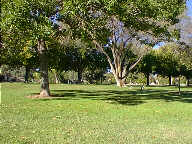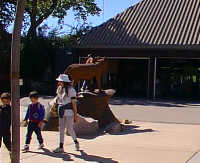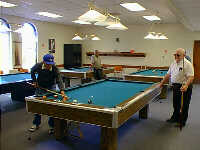 Recreation
is a human need across the world. No matter what the activity, recreation provides
opportunities to relax, learn, be healthy, socialize and enjoy leisure time.
Albuquerque's citizens are blessed with a mild climate that allows year-round
outdoor activity. The multicultural environment enhances recreation involving
the arts. Albuquerqueans love the outdoors, enjoy the arts, are interested in
health, fitness, sports competition, and a wide range of crafts and hobbies.
They have supported public funding of leisure and recreational programs. The
city provides recreation through several administrative departments: Cultural
and Recreational Services, Senior Affairs, Parks and General Services, and Family
and Community Services. City-sponsored recreation involves people of all ages
and interests and offers a range of leisure activities broad enough to provide
stimulation and relaxation.
Recreation
is a human need across the world. No matter what the activity, recreation provides
opportunities to relax, learn, be healthy, socialize and enjoy leisure time.
Albuquerque's citizens are blessed with a mild climate that allows year-round
outdoor activity. The multicultural environment enhances recreation involving
the arts. Albuquerqueans love the outdoors, enjoy the arts, are interested in
health, fitness, sports competition, and a wide range of crafts and hobbies.
They have supported public funding of leisure and recreational programs. The
city provides recreation through several administrative departments: Cultural
and Recreational Services, Senior Affairs, Parks and General Services, and Family
and Community Services. City-sponsored recreation involves people of all ages
and interests and offers a range of leisure activities broad enough to provide
stimulation and relaxation.
In order to maximize resources, the City works in cooperation with other private, quasi-public, and nonprofit recreation agencies such as the YMCA, YWCA, Boys and Girls Club, community youth sports groups such as the Albuquerque Youth Soccer Organization (AYSO), Little League, and Young America Football League(YAFL). Also, the city is a partner with the Albuquerque Public Schools (APS) in providing after-school recreation for elementary and middle-school youth.
Some recreation facilities are used on a drop-in, unscheduled basis by the community--playgrounds, community and senior centers, tennis courts, horseshoe courts, along with recreation trails. Other facilities such as swimming pools, golf courses and shooting range require an entry fee as does joining an adult sports league. Maloof Radio Controlled Park is a one-of-a-kind facility where model airplanes are flown Many programs, such as swimming and tennis lessons, require advance registration.
The city's continued population growth and limited funding for construction of facilities and operation of programs and services result in less than adequate facilities in some neighborhoods, insufficient programs, and unfilled needs. There is a need for new facilities in many areas of the city, increased funding to provide program expansion, and for more recreational services designed for teens. The need for increased personnel is an underlying problem. Additional funding could provide program expansion, and more dependable, well-trained volunteers could maximize the potential of recreational programs.
Young people need more recreational services. There is a growing problem with youth gang activities and at-risk youth linked to the changing family structure of unsupervised (latch-key) children, and single-parent families. The many retirees flocking to Albuquerque from all parts of the country constitute a challenging blend of backgrounds, interests, and states of health that deserve careful planning and creative implementation.
 |
The Cultural and Recreational Services Department sponsors a variety of recreational activities and programs for all ages. The focus is to give people lifelong leisure skills. These services include adult competitive league sports like flag football, basketball, softball and baseball. A variety of tennis programs are offered including reservations at the Albuquerque Tennis Complex and the Sierra Vista Complex. The department also coordinates the New Mexico Games, a yearly statewide competition in a variety of individual sports.
The department's Outdoor Recreation Section operates a shooting range, coordinates bicycling activities on recreational trails and provides a youth bicycle/pedestrian safety program. The Special Services Section coordinates contractual use of the Albuquerque Sports Stadium by the Albuquerque Dukes baseball team and rental of the stadium to others. Special Services also coordinates with the Albuquerque International Balloon Fiesta's use of Balloon Fiesta Park. A major project heading into 2000 is planning, funding and constructing an expanded Balloon Fiesta Park, which will be the city's largest multi-use park, over 300 acres, and cost many millions of dollars. However, the park will generate revenue for the city for years to come.
The Aquatics Program operates a year-round program at four pools with expanded summer programs at eight others. Instruction ranges from lessons for infants, beginning to intermediate swimmers, and lifesaving, which prepares teens for part-time employment as life guards. Youth may join swimming and water polo teams during the summer .
The Special Events program offers various free activities that emphasize the ethnic diversity of the community and strengthen neighborhoods. They also conduct unique yearly single-day or weekend events such as the Great Raft Race down the Rio Grande and Duke City Marathon. Cultural programs also include the Civic Chorus, which presents several concerts a year, and the Municipal Band which are open to both youth and adults who play an instrument. The Band performs for various events. The Arts in the Parks program provides free cultural entertainment in the city parks during the summer months. Entertainment includes flamenco dancing, mime, theater, puppets, and magic shows. Summerfest is a large festival held on certain Saturdays during the summer months, offering family entertainment on Civic Plaza.
The Family and Community Services Department was created in 1993 when the former Parks and Recreation Department was reorganized. It provides a variety of community recreational activities that also address social, health and human service needs and attempt to strengthen families. Recreational programs for all ages are offered. A comprehensive recreation program is coordinated for persons with disabilities.
Seventeen community centers provide a wide variety of recreational activities throughout the year for all ages. Highlights of the program include field trips to local places of interest, dancing, games, special events, arts, and crafts. Classes include arts and crafts, music, dance, nutrition, physical fitness, self-defense, and Southwestern cooking. Certain sites offer boxing. Centers are also used by many clubs for weekly meetings and activities such as the Albuquerque Table Tennis Club, which meets at the East San Jose Community Center. The Free Summer Food Program provides lunches for children at more than 50 locations in the metro area.
The Playground/Latch-key Program is designed to provide a safe, fun environment for children to enjoy supervised recreation/leisure activities. It is offered with the cooperation of APS after school during the school year and days during the summer break. School sites are arranged through APS, and efforts to spread sites throughout the metro area are being made. This varied program includes sports, games, arts and crafts, performing arts, fitness routines, field trips, and special events.
The Middle School Initiative Program started in 1992 and seeks to work with schools, neighborhood associations, and the surrounding business community to address at-risk youth, gang activity, and isolation of some children. Efforts funded include tutoring and counseling and various recreation activities This program was expanded to elementary schools in 1994. It is still in the process of working out scheduling and coordination with the preexisting community center/playground programs.
Therapeutic Recreation is a program that offers recreation opportunities to persons of all ages and abilities. Both mainstream and specialized programs are offered. The program stresses self- direction and involvement while offering new challenges and friendships. The program also offers technical expertise so that all city recreation programs include persons with disabilities. In cooperation with APS and various community service agencies, the year-round program sites are located throughout the city. Therapeutic Recreation Programs include:
There are four municipal golf courses in Albuquerque: Los Altos, Ladera, Arroyo del Oso, and Puerto del Sol. The courses are managed by golf professionals through contracts. These pros offer a variety of lessons and tournaments.
For additional information about services of the Cultural and Recreational Services Department, call 768-3550, and Family and Community Services, 768-2860.
 |
Albuquerque, one of the most attractive retirement communities in the rapidly growing Sunbelt, has a senior population that ranges from the impoverished frail and the elderly homebound to comfortable and vigorous pensioners. It includes Native Americans, Hispanics, and Anglos whose ancestral heritages are deeply rooted in New Mexican history and tradition, plus many postwar émigrés, who also exert a strong impact on Albuquerque's cultural and social patterns.
The Albuquerque/Bernalillo County Department of Senior Affairs (DSA) strives to improve the quality of life and match activities to the vitality of these older people of differing backgrounds and interest. A major DSA goal is to see that senior citizens, especially the aged poor, get the services they need and deserve. To meet this and other objectives, DSA offers a broad assortment of programs, including many recreational services, to enhance socialization and provide enriching experiences and fun. The wide ranging activities can be categorized as follows:
These activities are provided by the DSA working in coordination, when indicated, with the Housing Authority, various community agencies, UNM, and other educational institutions, Boys and Girls Clubs of Albuquerque, the county and city parks and recreation departments, the Arts Council, many public schools, and a variety of other organizations that provide senior citizens with leisure activities. Activities take place in the six city-funded senior centers.
It is difficult to determine whether we are meeting the recreational needs of our elderly population. Inadequate transportation to and from centers and other facilities has been a persistent problem that increases as Albuquerque continues to grow in size and as a retirement community. The population growth has led to overcrowding in the senior centers. We must also increase homebound recreational planning for those who cannot leave their homes.
Albuquerque's DSA is widely recognized for its pioneering effectiveness and resourcefulness in meeting senior recreational needs despite space, funding and staffing limitations. Excellent volunteer programs that augment staff commitment and energy have helped improve the quality of life for many older people by providing challenging creative outlets and constructive recreational opportunities that encourage our retirees to continue as active members of the community. Many of them are applying their own definition of reaction and finding stimulation, satisfaction, and fulfillment. For example, they volunteer in programs like RSVP, Volunteer Credit Bank, the Inter-generational Program, Foster Grandparents, Senior Companion, and a variety of other interest groups that help meet the needs of people of all ages in the community.
| __Los Altos Park | __other parks with softball fields |
| __KiMo Theater | __movie theaters |
| __Rio Grande Zoo | __museum |
| __Rio Grande Nature Center | __Sandia Peak Ski Area |
| __tennis courts | __park soccer fields |
| __swimming pools | __library |
| __Popejoy Hall | __art gallery |
| __recreation trail | __shooting range |
| __State Fair | __horse show |
| __others |
(Up to Section V, Back to Population Growth, On to Regionalism)